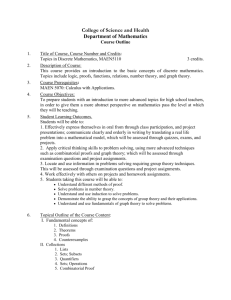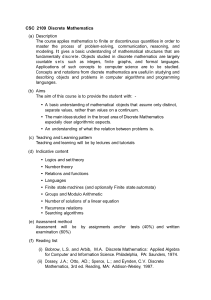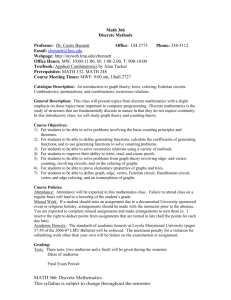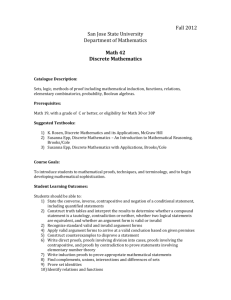cs260outline - Computer Science Home
advertisement
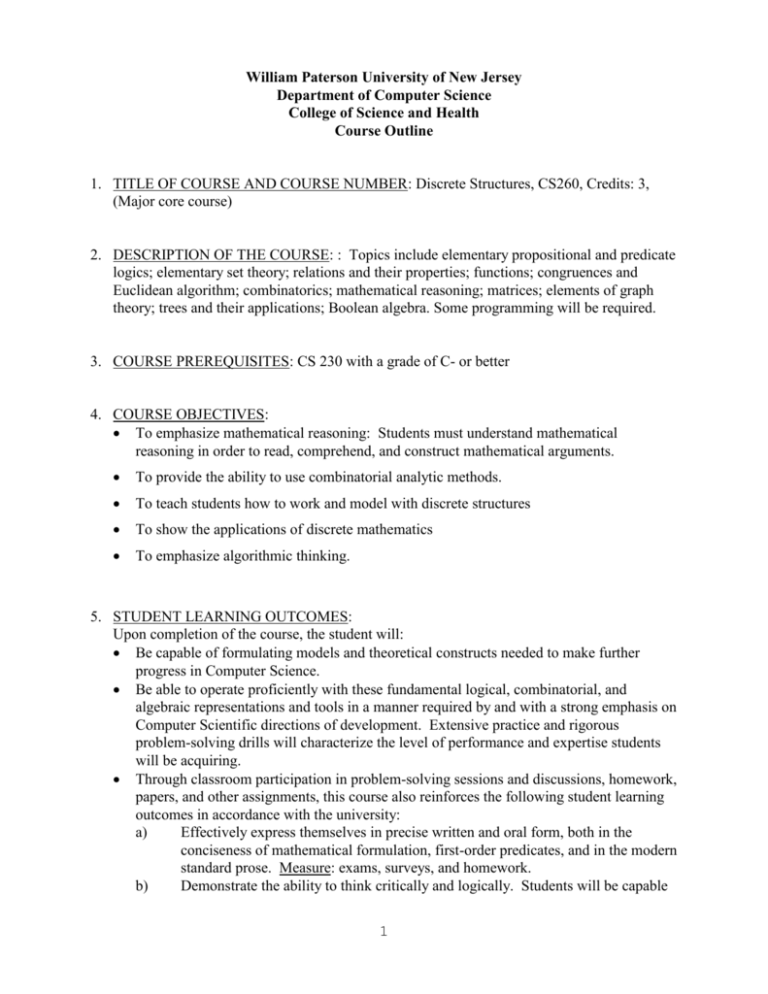
William Paterson University of New Jersey Department of Computer Science College of Science and Health Course Outline 1. TITLE OF COURSE AND COURSE NUMBER: Discrete Structures, CS260, Credits: 3, (Major core course) 2. DESCRIPTION OF THE COURSE: : Topics include elementary propositional and predicate logics; elementary set theory; relations and their properties; functions; congruences and Euclidean algorithm; combinatorics; mathematical reasoning; matrices; elements of graph theory; trees and their applications; Boolean algebra. Some programming will be required. 3. COURSE PREREQUISITES: CS 230 with a grade of C- or better 4. COURSE OBJECTIVES: To emphasize mathematical reasoning: Students must understand mathematical reasoning in order to read, comprehend, and construct mathematical arguments. To provide the ability to use combinatorial analytic methods. To teach students how to work and model with discrete structures To show the applications of discrete mathematics To emphasize algorithmic thinking. 5. STUDENT LEARNING OUTCOMES: Upon completion of the course, the student will: Be capable of formulating models and theoretical constructs needed to make further progress in Computer Science. Be able to operate proficiently with these fundamental logical, combinatorial, and algebraic representations and tools in a manner required by and with a strong emphasis on Computer Scientific directions of development. Extensive practice and rigorous problem-solving drills will characterize the level of performance and expertise students will be acquiring. Through classroom participation in problem-solving sessions and discussions, homework, papers, and other assignments, this course also reinforces the following student learning outcomes in accordance with the university: a) Effectively express themselves in precise written and oral form, both in the conciseness of mathematical formulation, first-order predicates, and in the modern standard prose. Measure: exams, surveys, and homework. b) Demonstrate the ability to think critically and logically. Students will be capable 1 c) d) of developing rigorous (though fundamental) mathematical proofs (on their own). They will be capable of reasoning through several methods of inference including direct, indirect, by-contradiction, enumerative, and other methods. They will be expected to formulate problems and reason by the application of both propositional and predicate logic. Measure: exams, surveys, and projects. Optional: Locate and use information in the process of solving problems. Measure: projects. Demonstrate the ability to integrate knowledge and ideas in a coherent and meaningful manner. Measure: exams and surveys. 6. TOPICAL OUTLINE OF THE COURSE CONTENT: 1) Logic; propositional equivalence; predicates and quantifiers. 2) Sets and set operations 3) Functions 4) Sequences and summations 5) The Growth of functions and complexity of algorithms 6) Congruences and Euclidean algorithms 7) Matrices 8) Methods of proofs 9) Mathematical induction; recursive definitions and recursive algorithms 10) Program correctness 11) Combinatorics: The basics of counting; the pigeonhole principle; permutations and combinations; discrete probability; generating permutations and combinations. 12) Recurrence relations 13) Relations: Relations and their properties; n-ary relations and their applications; representing relations; equivalence relations; partial orderings 14) Graphs: Introduction to graphs; graph terminology; representation of graphs and graph isomorphism; connectivity; Euler and Hamilton paths; shortest path; planar graphs; graph coloring. 15) Introduction to trees and their applications. 16) Boolean Algebra: Boolean functions; sum-of-products; logic gates. 7. GUIDELINES/SUGGESTIONS FOR TEACHING METHODS AND STUDENT LEARNING ACTIVITIES: A. Classroom lectures and problem-solving sessions B. Open Lab. sessions 2 8. GUIDELINES/SUGGESTIONS FOR METHODS OF STUDENT ASSESSMENT (OUTCOMES): 1) Periodic examinations and final examination. 2) Homework assignments. 3) Programming assignments. 9. SUGGESTED READINGS, TEXTS, OBJECTS OF STUDY: Discrete Mathematics and Its Applications, 5th edition, Kenneth H. Rosen, 2003, McGraw Hill, Inc. Schaum's Outline of Theory and Problems of Discrete Mathematics, Seymour Lipschutz, and Marc Lipson, 1997, McGraw Hill, Inc. 10. BIBLIOGRAPHY OF SUPPORTIVE TEXTS AND OTHER MATERIALS: Introductory Graph Theory, Gary Chartrand, 1985, Dover Discrete Mathematics with Applications (3rd Ed.), Susanna S. Epp, 2004, Brooks/Cole (An International Thomson Company). A Logical Approach to Discrete Math, David Gries and Fred B Schneider, 1993, Springer-Verlag. Discrete Mathematics for Computer Science (w Student Solutions Manual CD-ROM), Gary Haggard, John Schlipf, and Sue Whitesides, 2006, Brooks/Cole (An International Thomson Company). Logic in Computer Science, M. Huth and M. Ryan, 2000, Cambridge University Press. Discrete Mathematics (6th Ed.), Richard. Johnsonbaugh, 2005, Prentice-Hall. Discrete Mathematical Structures (5th Ed.), Bernard Kolman, Robert C. Busby, Sharon, and Cutler Ross, 2004, Prentice-Hall Handbook of Discrete and Combinatorial Mathematics, Kenneth H. Rosen, John Michaels, and Jonathan Gross (editors), 1999. CRC Press. Discrete Mathematics Proof Techniques and Mathematical Structures, R.C. Penner, 1999, World Scientific Pub Co. 3 Relations and Graphs : Discrete Mathematics for Computer Scientists, Gunther Schmidt and Thomas Strohlein, 1993, Springer Verlag. Discrete Mathematics for Computer Science, Angela Shiflet, 1987, West Information Pub. Discrete Mathematics in Computer Science, Donald Stanat and David McAllister, 1977, Prentice Hall. Discrete Mathematics for Computer Scientists, J. K. Truss, 1999, Addison-Wesley. 11. PREPARER'S NAME AND DATE: Dr. John Najarian 12. ORIGINAL DEPARTMENTAL APPROVAL DATE: Spring, 1996 13. REVISERS' NAME AND DATE: Dr. John Najarian, Spring 2000 and Fall 2004 14. DEPARTMENTAL REVISION APPROVAL DATE: 4 Fall 2004

